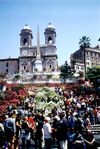Venice
| Venice Venezia |
|
|---|---|
| — Comune — | |
| Comune di Venezia | |
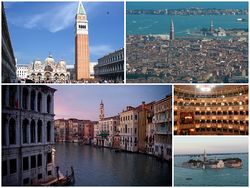 |
|
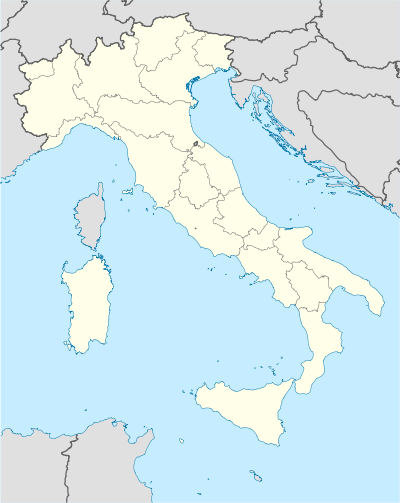 Venice
|
|
| Coordinates: | |
| Country | Italy |
| Region | Veneto |
| Province | Venice (VE) |
| Frazioni | Chirignago, Favaro Veneto, Mestre, Marghera, Murano, Burano, Giudecca, Lido, Zelarino |
| Government | |
| - Mayor | Giorgio Orsoni (Democratic Party) |
| Area | |
| - Total | 414.57 km2 (160.1 sq mi) |
| Elevation | 0 m (0 ft) |
| Population (2009-04-30) | |
| - Total | 270,660 |
| - Density | 652.9/km2 (1,690.9/sq mi) |
| Demonym | Venetians |
| Time zone | CET (UTC+1) |
| - Summer (DST) | CEST (UTC+2) |
| Postal code | 30100 |
| Dialing code | 041 |
| Patron saint | St. Mark the Evangelist |
| Saint day | 25 April |
| Website | Official website |
| Venice and its Lagoon* | |
|---|---|
| UNESCO World Heritage Site | |
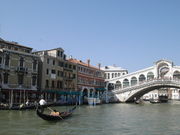 |
|
| State Party | |
| Type | Cultural |
| Criteria | i, ii, iii, iv, v, vi |
| Reference | 394 |
| Region** | Europe and North America |
| Inscription history | |
| Inscription | 1987 (11th Session) |
| * Name as inscribed on World Heritage List. ** Region as classified by UNESCO. |
|
Venice (Italian: Venezia [veˈnɛttsia] (![]() listen), Venetian: Venesia) is a city in northern Italy known both for tourism and for industry, and is the capital of the region Veneto, with a population of 271,367 (census estimate 1 January 2004). Together with Padua, the city is included in the Padua-Venice Metropolitan Area (population 1,600,000). The name is derived from the ancient tribe of Veneti that inhabited the region in Roman times.[1][2] The city historically was the capital of an independent city-state. Venice has been known as the "La Dominante", "Serenissima", "Queen of the Adriatic", "City of Water", "City of Masks", "City of Bridges", "The Floating City", and "City of Canals". Luigi Barzini, writing in The New York Times, described it as "undoubtedly the most beautiful city built by man".[3] Venice has also been described by the Times Online as being one of Europe's most romantic cities.[4] The city stretches across 117 small islands in the marshy Venetian Lagoon along the Adriatic Sea in northeast Italy. The saltwater lagoon stretches along the shoreline between the mouths of the Po (south) and the Piave (north) Rivers. The population estimate of 272,000 inhabitants includes the population of the whole Comune of Venezia; around 60,000[5] in the historic city of Venice (Centro storico); 176,000 in Terraferma (the Mainland), mostly in the large frazioni of Mestre and Marghera; and 31,000 live on other islands in the lagoon. The Republic of Venice was a major maritime power during the Middle Ages and Renaissance, and a staging area for the Crusades and the Battle of Lepanto, as well as a very important center of commerce (especially silk, grain and spice trade) and art in the 13th century up to the end of the 17th century. This made Venice a wealthy city throughout most of its history.[6] It is also known for its several important artistic movements, especially the Renaissance period. Venice has played an important role in the history of symphonic and operatic music, and it is the birthplace of Antonio Vivaldi.
listen), Venetian: Venesia) is a city in northern Italy known both for tourism and for industry, and is the capital of the region Veneto, with a population of 271,367 (census estimate 1 January 2004). Together with Padua, the city is included in the Padua-Venice Metropolitan Area (population 1,600,000). The name is derived from the ancient tribe of Veneti that inhabited the region in Roman times.[1][2] The city historically was the capital of an independent city-state. Venice has been known as the "La Dominante", "Serenissima", "Queen of the Adriatic", "City of Water", "City of Masks", "City of Bridges", "The Floating City", and "City of Canals". Luigi Barzini, writing in The New York Times, described it as "undoubtedly the most beautiful city built by man".[3] Venice has also been described by the Times Online as being one of Europe's most romantic cities.[4] The city stretches across 117 small islands in the marshy Venetian Lagoon along the Adriatic Sea in northeast Italy. The saltwater lagoon stretches along the shoreline between the mouths of the Po (south) and the Piave (north) Rivers. The population estimate of 272,000 inhabitants includes the population of the whole Comune of Venezia; around 60,000[5] in the historic city of Venice (Centro storico); 176,000 in Terraferma (the Mainland), mostly in the large frazioni of Mestre and Marghera; and 31,000 live on other islands in the lagoon. The Republic of Venice was a major maritime power during the Middle Ages and Renaissance, and a staging area for the Crusades and the Battle of Lepanto, as well as a very important center of commerce (especially silk, grain and spice trade) and art in the 13th century up to the end of the 17th century. This made Venice a wealthy city throughout most of its history.[6] It is also known for its several important artistic movements, especially the Renaissance period. Venice has played an important role in the history of symphonic and operatic music, and it is the birthplace of Antonio Vivaldi.
Contents |
History
Origins
While there are no historical records that deal directly with the obscure and peripheral[7] origins of Venice, tradition and the available evidence have led several historians to agree that the original population of Venice consisted of refugees from Roman cities such as Padua, Aquileia, Altino and Concordia (modern Portogruaro) and from the undefended countryside, who were fleeing successive waves of Germanic invasions and Huns.[8] Some late Roman sources reveal the existence of fishermen on the islands in the original marshy lagoons. They were referred to as incolae lacunae ("lagoon dwellers"). The traditional founding is identified with the dedication of the first church, that of San Jacopo at the islet of Rialto (Rivoalto, "High Shore"), given a conventional date of 421.[9]
The last and most enduring irruption in the north of the Italian peninsula, was that of the Lombards in 568, leaving the Eastern Roman Empire a small strip of coast in the current Veneto, and the main administrative and religious entities were therefore transferred to this remaining dominion, centered upon the Exarchate of Ravenna, the local representative of the Emperor in the East. The Venetian tradition of the islanders' aid to Belisarius was reported in early histories to explain the largely theoretical link to Ravenna, and to the Eastern Emperor. New ports were built, including those at Malamocco and Torcello in the Venetian lagoon. The tribuni maiores, the earliest central standing governing committee of the islands in the Lagoon, dated from c. 568.[10]
The Venetians traditionally having offered asylum to the Exarch, in flight from the Lombard Liutprand,[11] the Byzantine domination of central and northern Italy was subsequently largely eliminated by the conquest of the Exarchate of Ravenna in 751 by Aistulf. During this period, the seat of the local Byzantine governor (the "duke/dux", later "doge") was situated in Malamocco. Settlement on the islands in the lagoon probably increased in correspondence with the Lombardo conquest of the Byzantine territories.
Sometime in the first decades of the eighth century, the people of the lagoon elected their first leader Ursus, who was confirmed by Byzantium and given the titles of hypatus and dux.[12] He was the first historical Doge of Venice.
In 775-76, the bishopric seat of Olivolo (Helipolis) was created. During the reign of duke Agnello Particiaco (811-827) the ducal seat was moved from Malamocco to the highly protected Rialto, the current location of Venice. The monastery of St. Zachary and the first ducal palace and basilica of St. Mark, as well as a walled defense (civitatis murus) between Olivolo and Rialto were subsequently built here. Winged lions which may be seen in Venice are a symbol for St. Mark.
In 810, an agreement between Charlemagne and Nicephorus recognized Venice as Byzantine territory and recognized the city's trading rights along the Adriatic coast, where Charlemagne had previously ordered the pope to expel the Venetians from the Pentapolis.[13] In 828, the new city's prestige was raised by the acquisition of the claimed relics of St. Mark the Evangelist from Alexandria, which were placed in the new basilica. The patriarchal seat was also moved to Rialto. As the community continued to develop and as Byzantine power waned, it led to the growth of autonomy and eventual independence.


Expansion
From the ninth to the twelfth century Venice developed into a city state (an Italian thalassocracy or Repubblica Marinara, the other three being Genoa, Pisa, and Amalfi). Its strategic position at the head of the Adriatic made Venetian naval and commercial power almost invulnerable. With the elimination of pirates along the Dalmatian coast, the city became a flourishing trade center between Western Europe and the rest of the world (especially the Byzantine Empire and the Islamic world). In the 12th century the foundations of Venice's power were laid: the Venetian Arsenal was under construction in 1104; the last autocratic doge, Vital II Michele, died in 1172.
The Republic of Venice seized a number of locations on the eastern shores of the Adriatic before 1200, mostly for commercial reasons, because pirates based there were a menace to trade. The Doge already carried the titles of Duke of Dalmatia and Duke of Istria. Later mainland possessions, which extended across Lake Garda as far west as the Adda River, were known as the "Terraferma", and were acquired partly as a buffer against belligerent neighbours, partly to guarantee Alpine trade routes, and partly to ensure the supply of mainland wheat, on which the city depended. In building its maritime commercial empire, the Republic dominated the trade in salt,[14] acquired control of most of the islands in the Aegean, including Cyprus and Crete, and became a major power-broker in the Near East. By the standards of the time, Venice's stewardship of its mainland territories was relatively enlightened and the citizens of such towns as Bergamo, Brescia and Verona rallied to the defence of Venetian sovereignty when it was threatened by invaders.
Venice remained closely associated with Constantinople, being twice granted trading privileges in the Eastern Roman Empire, through the so-called Golden Bulls or 'chrysobulls' in return for aiding the Eastern Empire to resist Norman and Turkish incursions. In the first chrysobull Venice acknowledged its homage to the Empire but not in the second, reflecting the decline of Byzantium and the rise of Venice's power.[15][16]
Venice became an imperial power following the Venetian-financed Fourth Crusade, which in 1204 seized and sacked Constantinople and established the Latin Empire. As a result of this conquest considerable Byzantine plunder was brought back to Venice. This plunder included the gilt bronze horses from the Hippodrome of Constantinople which were now placed above the entrance to St Mark's cathedral in Venice, where they remain to this day. Following the fall of Constantinople the former Roman Empire was partitioned among the Latin crusaders and the Venetians. Venice subsequently carved out a sphere of influence in the Mediterranean known as the Duchy of the Archipelago, and seized Crete.
The seizure of Constantinople would ultimately prove as decisive a factor in ending the Byzantine Empire as the loss of the Anatolian themes after Manzikert. Though the Byzantines recovered control of the ravaged city a half century later, the Byzantine Empire was greatly weakened, and existed as a ghost of its old self, struggling on with the help, among other things, of loans from Venice (never repaid) until Sultan Mehmet The Conqueror took the city in 1453.

Situated on the Adriatic Sea, Venice always traded with the Byzantine Empire and the Muslim world extensively. By the late thirteenth century, Venice was the most prosperous city in all of Europe. At the peak of its power and wealth, it had 36,000 sailors operating 3,300 ships, dominating Mediterranean commerce. During this time, Venice's leading families vied with each other to build the grandest palaces and support the work of the greatest and most talented artists. The city was governed by the Great Council, which was made up of members of the noble families of Venice. The Great Council appointed all public officials and elected a Senate of 200 to 300 individuals. Since this group was too large for efficient administration, a Council of Ten (also called the Ducal Council or the Signoria), controlled much of the administration of the city. One member of the great council was elected "Doge", or duke, the ceremonial head of the city, who normally held the title until his death.
The Venetian governmental structure was similar in some ways to the republican system of ancient Rome, with an elected chief executive (the Doge), a senate-like assembly of nobles, and a mass of citizens with limited political power, who originally had the power to grant or withhold their approval of each newly elected Doge. Church and various private properties were tied to military service, though there was no knight tenure within the city itself. The Cavalieri di San Marco was the only order of chivalry ever instituted in Venice, and no citizen could accept or join a foreign order without the government's consent. Venice remained a republic throughout its independent period and politics and the military were kept separate, except when on occasion the Doge personally headed the military. War was regarded as a continuation of commerce by other means (hence, the city's early production of large numbers of mercenaries for service elsewhere, and later its reliance on foreign mercenaries when the ruling class was preoccupied with commerce).
The chief executive was the Doge, who theoretically held his elective office for life. In practice, several Doges were forced by pressure from their oligarchical peers to resign the office and retire into monastic seclusion when they were felt to have been discredited by perceived political failure.
Though the people of Venice generally remained orthodox Roman Catholics, the state of Venice was notable for its freedom from religious fanaticism and it enacted not a single execution for religious heresy during the Counter-Reformation. This apparent lack of zeal contributed to Venice's frequent conflicts with the Papacy. In this context, the writings of the Anglican Divine, William Bedell, are particularly illuminating. Venice was threatened with the interdict on a number of occasions and twice suffered its imposition. The second, most famous, occasion was on 27 April 1509, by order of Pope Julius II (see League of Cambrai).
Venetian ambassadors sent home still-extant secret reports of the politics and rumours of European courts, providing fascinating information to modern historians.
The newly invented German printing press spread rapidly throughout Europe in the fifteenth century, and Venice was quick to adopt it. By 1482 Venice was the printing capital of the world, and the leading printer was Aldus Manutius, who invented the concept of paperback books that could be carried in a saddlebag. His Aldine Editions included translations of nearly all the known Greek manuscripts of the era.[17]
Decline
Venice’s long decline started in the 15th century, when it first made an unsuccessful attempt to hold Thessalonica against the Ottomans (1423–1430). She also sent ships to help defend Constantinople against the besieging Turks (1453). After the city fell to Sultan Mehmet II he declared war on Venice. The war lasted thirty years and cost Venice much of her eastern Mediterranean possessions. Next, Christopher Columbus discovered the New World. Then Portugal found a sea route to India, destroying Venice’s land route monopoly. France, England and Holland followed them. Venice’s oared galleys had no advantage when it came to traversing the great oceans. She was left behind in the race for colonies.
The Black Death devastated Venice in 1348 and once again between 1575 and 1577.[18] In three years the plague killed some 50,000 people.[19] In 1630, the plague killed a third of Venice's 150,000 citizens.[20] Venice began to lose its position as a center of international trade during the later part of the Renaissance as Portugal became Europe's principal intermediary in the trade with the East, striking at the very foundation of Venice's great wealth, while France and Spain fought for hegemony over Italy in the Italian Wars, marginalising its political influence. However, the Venetian empire was a major exporter of agricultural products and, until the mid-18th century, a significant manufacturing center.
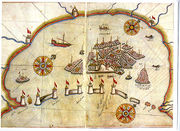
By 1303, crossbow practice had become compulsory in the city, with citizens training in groups. As weapons became more expensive and complex to operate, professional soldiers were assigned to help work merchant sailing ships and as rowers in galleys. The company of "Noble Bowmen" was recruited in the later 14th century from among the younger aristocracy and served aboard both war-galleys and as armed merchantmen, with the privilege of sharing the captain's cabin.
Though Venice was famous for its navy, its army was equally effective. In the 13th century, most Italian city states already were hiring mercenaries, but Venetian troops were still recruited from the lagoon, plus feudal levies from Dalmatia (the very famous Schiavoni or Oltremarini)[21] and Istria. In times of emergency, all males between seventeen and sixty years were registered and their weapons were surveyed, with those called to actually fight being organized into companies of twelve. The register of 1338 estimated that 30,000 Venetian men were capable of bearing arms; many of these were skilled crossbowmen. As in other Italian cities, aristocrats and other wealthy men were cavalrymen while the city's conscripts fought as infantry.
By 1450, more than 3,000 Venetian merchant ships were in operation. Most of these could be converted when necessary into either warships or transports. The government required each merchant ship to carry a specified number of weapons (mostly crossbows and javelins) and armour; merchant passengers were also expected to be armed and to fight when necessary. A reserve of some 25 (later 100) war-galleys was maintained in the Arsenal. Galley slaves did not exist in medieval Venice, the oarsmen coming from the city itself or from its possessions, especially Dalmatia. Those from the city were chosen by lot from each parish, their families being supported by the remainder of the parish while the rowers were away. Debtors generally worked off their obligations rowing the galleys. Rowing skills were encouraged through races and regattas.
Early in the 15th century, as new mainland territories were expanded, the first standing army was organized, consisting of condottieri on contract. In its alliance with Florence in 1426, Venice agreed to supply 8,000 cavalry and 3,000 infantry in time of war, and 3,000 and 1,000 in peacetime. Later in that century, uniforms were adopted that featured red-and-white stripes, and a system of honors and pensions developed. Throughout the 15th century, Venetian land forces were almost always on the offensive and were regarded as the most effective in Italy, largely because of the tradition of all classes carrying arms in defense of the city and official encouragement of general military training.
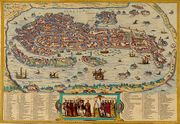
The command structure in the army was different from that of the fleet. By ancient law, no nobleman could command more than twenty-five men (to prevent the possibility of sedition by private armies), and while the position of Captain General was introduced in the mid-14th century, he still had to answer to a civilian panel of twenty Savi or "wise men". Not only was efficiency not degraded, this policy saved Venice from the military takeovers that other Italian city states so often experienced. A civilian commissioner (not unlike a commissar) accompanied each army to keep an eye on things, especially the mercenaries. The Venetian military tradition also was notably cautious; they were more interested in achieving success with a minimum expense of lives and money than in the pursuit of glory.
Modern age
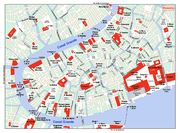
After 1,070 years, the Republic lost independence when Napoleon Bonaparte on 12 May 1797, conquered Venice during the First Coalition. The French conqueror brought to an end the most fascinating century of its history: during the Settecento (18th century) Venice became perhaps the most elegant and refined city in Europe, greatly influencing art, architecture and literature. Napoleon was seen as something of a liberator by the city's Jewish population, although it can be argued they had lived with fewer restrictions in Venice. He removed the gates of the Ghetto and ended the restrictions on when and where Jews could live and travel in the city.
Venice became Austrian territory when Napoleon signed the Treaty of Campo Formio on 12 October 1797. The Austrians took control of the city on 18 January 1798. It was taken from Austria by the Treaty of Pressburg in 1805 and became part of Napoleon's Kingdom of Italy, but was returned to Austria following Napoleon's defeat in 1814, when it became part of the Austrian-held Kingdom of Lombardy-Venetia. In 1848-1849 a revolt briefly reestablished the Venetian Republic under Daniele Manin. In 1866, following the Third Italian War of Independence, Venice, along with the rest of the Veneto, became part of the newly created Kingdom of Italy.
During the Second World War, the historic city was largely free from attack, the only aggressive effort of note being Operation Bowler, a precision strike on the German naval operations there in 1945. However the industrial areas in Mestre and Marghera and the railway lines to Padua, Trieste and Trento were repeatedly bombed.[22] On 29 April 1945 New Zealand troops under Freyberg reached Venice and relieved the city and the mainland, who were already in partisan hands.[23]
Geography

Cannaregio
Castello
Dorsoduro
San Marco
San Polo
Santa Croce

The city is divided into six areas or "sestiere". These are Cannaregio, San Polo, Dorsoduro (including the Giudecca and Isola Sacca Fisola), Santa Croce, San Marco (including San Giorgio Maggiore) and Castello (including San Pietro di Castello and Sant'Elena). Each sestiere was administered by a procurator and his staff.
These districts consist of parishes — initially seventy in 1033, but reduced under Napoleon and now numbering just thirty-eight. These parishes predate the sestieri, which were created in about 1170.
Other islands of the Venetian Lagoon do not form part of any of the sestieri, having historically enjoyed a considerable degree of autonomy.
Each sestiere has its own house numbering system. Each house has a unique number in the district, from one to several thousand, generally numbered from one corner of the area to another, but not usually in a readily understandable manner.
At the front of the Gondolas that work in the city there is a large piece of metal intended as a likeness of the Doge's hat. On this sit six notches pointing forwards and one pointing backwards. Each of these represent one of the Sestieri (the one which points backwards represents the Giudecca).
Sinking of Venice

.jpg)
The buildings of Venice are constructed on closely spaced wood piles, which were imported from the mainland. (Under water, in the absence of oxygen, wood does not decay. It is petrified as a result of the constant flow of mineral-rich water around and through it, so that it becomes a stone-like structure.) The piles penetrate a softer layer of sand and mud until they reach the much harder layer of compressed clay. Wood for piles was cut in the most western part of today's Slovenia, resulting in the barren land in a region today called Kras, and in two regions of Croatia, Lika and Gorski kotar (resulting in the barren slopes of Velebit). Most of these piles are still intact after centuries of submersion. The foundations rest on the piles, and buildings of brick or stone sit above these footings. The buildings are often threatened by flood tides pushing in from the Adriatic between autumn and early spring.
Six hundred years ago, Venetians protected themselves from land-based attacks by diverting all the major rivers flowing into the lagoon and thus preventing sediment from filling the area around the city. This created an ever-deeper lagoon environment.
During the 20th century, when many artesian wells were sunk into the periphery of the lagoon to draw water for local industry, Venice began to subside. It was realized that extraction of the aquifer was the cause. This sinking process has slowed markedly since artesian wells were banned in the 1960s. However, the city is still threatened by more frequent low-level floods (called Acqua alta, "high water") that creep to a height of several centimetres over its quays, regularly following certain tides. In many old houses the former staircases used by people to unload goods are now flooded, rendering the former ground floor uninhabitable.
Some recent studies have suggested that the city is no longer sinking,[24][25] but this is not yet certain; therefore, a state of alert has not been revoked. In May 2003 the Italian Prime Minister Silvio Berlusconi inaugurated the MOSE project (Modulo Sperimentale Elettromeccanico), an experimental model for evaluating the performance of inflatable gates; the idea is to lay a series of 79 inflatable pontoons across the sea bed at the three entrances to the lagoon. When tides are predicted to rise above 110 centimetres, the pontoons will be filled with air and block the incoming water from the Adriatic Sea. This engineering work is due to be completed by 2011.

In 1604, to defray the cost of flood relief Venice introduced what could be considered the first example of what became elsewhere a 'stamp tax'. When the revenue fell short of expectations in 1608 Venice introduced paper with the superscription 'AQ' and imprinted instructions which was to be used for 'letters to officials'. Initially this was to be a temporary tax but in fact remained in effect to the fall of the Republic in 1797. Shortly after the introduction of the tax Spain produced similar paper for more general taxation purposes and the practice spread to other countries.
Climate
According to the Köppen climate classification, Venice has a Humid subtropical climate (Cfa), with cool winters and very warm summers. The 24-hour average in January is 2.5 °C (36.5 °F), and for July this figure is 22.7 °C (72.9 °F). Precipitation is spread relatively evenly throughout the year, and averages 801 millimetres (31.5 in).
| Climate data for Venice (1961-1990) | |||||||||||||
|---|---|---|---|---|---|---|---|---|---|---|---|---|---|
| Month | Jan | Feb | Mar | Apr | May | Jun | Jul | Aug | Sep | Oct | Nov | Dec | Year |
| Average high °C (°F) | 5.8 (42.4) |
8.2 (46.8) |
12.0 (53.6) |
16.3 (61.3) |
21.2 (70.2) |
24.8 (76.6) |
27.5 (81.5) |
27.0 (80.6) |
23.6 (74.5) |
18.1 (64.6) |
11.5 (52.7) |
6.7 (44.1) |
16.9 (62.4) |
| Average low °C (°F) | -0.9 (30.4) |
0.7 (33.3) |
3.8 (38.8) |
7.9 (46.2) |
12.3 (54.1) |
15.9 (60.6) |
17.8 (64) |
17.3 (63.1) |
14.2 (57.6) |
9.4 (48.9) |
4.2 (39.6) |
0.0 (32) |
8.6 (47.5) |
| Precipitation mm (inches) | 58.1 (2.287) |
54.2 (2.134) |
57.1 (2.248) |
64.3 (2.531) |
68.7 (2.705) |
76.4 (3.008) |
63.1 (2.484) |
83.1 (3.272) |
66.0 (2.598) |
69.0 (2.717) |
87.3 (3.437) |
53.7 (2.114) |
801 (31.54) |
| % Humidity | 81 | 77 | 75 | 75 | 73 | 74 | 71 | 72 | 75 | 77 | 79 | 81 | 75.8 |
| Avg. precipitation days | 6.7 | 6.2 | 6.6 | 8.2 | 8.3 | 8.9 | 5.7 | 6.7 | 5.4 | 6 | 7.7 | 6.4 | 82.8 |
| Sunshine hours | 80.6 | 107.4 | 142.6 | 174.0 | 229.4 | 243.0 | 288.3 | 257.3 | 198.0 | 151.9 | 87.0 | 77.5 | 2,037 |
| Source: MeteoAM [26] | |||||||||||||
Economy
Venice's economy has greatly changed throughout history, and has evolved greatly. In the Middle-Ages and the Renaissance, Venice was a major centre for commerce and trade, as it controlled a vast sea-empire, and became an extremely wealthy European city, a leader in political and economic affairs and a centre for trade and commerce.[27] This all changed by the 17th century, when Venice's trade empire was taken over by other countries such as Portugal, and its naval importance was reduced. In the 18th century, then, it became a major agricultural and industrial exporter. The 18th century's biggest industrial complex was the Venice Arsenal, and the Italian Army still uses it today (even though some space has been used for major theatrical and cultural productions, and beautiful spaces for art).[28] Today, Venice's economy is mainly based on tourism, shipbuilding (mainly done in the neighbouring cities of Mestre and Porto Marghera), services, trade and industrial exports.[27] Murano glass production in Murano and lace production in Burano are also highly important to the economy.[27]
Tourism
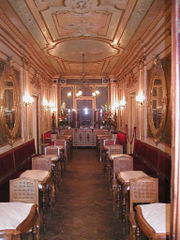
Venice is one of the most important tourist destinations in the world, due to the city being one of the world's greatest and most beautiful cities of art.[29] The city has an average of 50,000 tourists a day (2007 estimate).[30] In 2006, it was the world's 28th most internationally visited city, with 2.927 million international arrivals that year.[31]
Tourism has been a major sector of Venetian industry since the 18th century, when it was a major centre for the grand tour, due to its beautiful cityscape, uniqueness and rich musical and artistic cultural heritage. In the 19th century, it became a fashionable centre for the rich and famous, often staying or dining at luxury establishments such as the Danieli Hotel and the Caffè Florian. It continued being a fashionable city in vogue right into the early 20th century.[29] In the 1980s, the Carnival of Venice was revived and the city has become a major centre of international conferences and festivals, such as the prestigious Venice Biennale and the Venice Film Festival, which attract visitors from all over the world for their theatrical, cultural, cinematic, artistic and musical productions[29]
Today there are numerous attractions in Venice, such as St Mark's Basilica, the Grand Canal, and the Piazza San Marco, to name a few. The Lido di Venezia is also a popular international luxury destination, attracting thousands of actors, critics, celebrities and mainly people in the cinematic industry.[29]
However, Venice's popularity as a major worldwide tourist destination has caused several problems, including the fact that the city can be very overcrowded at some points of the year. It is regarded by some as a tourist trap, and by others as a 'living museum'.[29] The competition for foreigners to buy homes in Venice has made prices rise so highly, that numerous inhabitants are forced to move to more affordable areas of Veneto and Italy, most notably Mestre.
Transportation


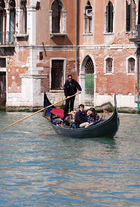
Venice is world-famous for its canals. It is built on an archipelago of 117 islands formed by 177 canals in a shallow lagoon. The islands on which the city is built are connected by 455 bridges.[32] In the old centre, the canals serve the function of roads, and almost every form of transport is on water or on foot. In the 19th century a causeway to the mainland brought a railway station to Venice, and an automobile causeway and parking lot was added in the 20th century. Beyond these land entrances at the northern edge of the city, transportation within the city remains, as it was in centuries past, entirely on water or on foot. Venice is Europe's largest urban car free area, unique in Europe in remaining a sizable functioning city in the 21st century entirely without motorcars or trucks.
Waterways
The classical Venetian boat is the gondola, although it is now mostly used for tourists, or for weddings, funerals, or other ceremonies. Many gondolas are lushly appointed with crushed velvet seats and Persian rugs. Gondoliers typically charge between 80 and 100 euros for a 35 minute "giro" or excursion around some canals. To be a Gondolier you must be an Italian or E.U. Citizen. Most Venetians now travel by motorised waterbuses (vaporetti) which ply regular routes along the major canals and between the city's islands. The city also has many private boats. The only gondolas still in common use by Venetians are the traghetti, foot passenger ferries crossing the Grand Canal at certain points without bridges. Visitors can also take the water taxis between areas of the city.
Public transportation
Azienda Consorzio Trasporti Veneziano (ACTV) is the name of the public transport system in Venice. It combines both land transportation, with buses, and canal travel, with water buses (vaporetti). In total, there are 25 routes which connect the city. A one way pass good for one hour costs 6.50 €; longer term passes for 12 to 72 hours are available, costing 14 to 31 €. An even better deal is the "Venice Card" for 7 days, starting at 47.50 €, which includes unlimited vaporetto travel.
The ticket used by ACTV is a new style smartcard
The Venice People Mover (managed by ASM) is a cable operated public transit system connecting Tronchetto island with Piazzale Roma.
Venice also has water taxis, which are fast but quite expensive.
Airports
Venice is served by the newly rebuilt Marco Polo International Airport, or Aeroporto di Venezia Marco Polo, named in honor of its famous citizen. The airport is on the mainland and was rebuilt away from the coast; however, the water taxis or Alilaguna waterbuses to Venice are only a seven-minute walk from the terminals.
Some airlines market Treviso Airport in Treviso, 30 km from Venice, as a Venice gateway. Some simply advertise flights to "Venice" without naming the actual airport except in the small print.[33]
Trains
Venice is serviced by regional and national trains. One of the easiest ways to travel from Rome or other large Italian cities is to use the train. Rome is only slightly over four hours away; Milan is slightly over two and a half hours away. Treviso is thirty-five minutes away.[34] Florence and Padua are two of the stops between Rome and Venice. The St. Lucia station is a few steps away from a vaporetti stop.
The station is the terminus and starting point of the Venice Simplon Orient Express from or to London Victoria and Paris.
Car
The maritime portion of Venice has no streets as such, being composed almost entirely of narrow footpaths, and laid out across islands connected by staired stone footbridges, making transportation impossible by almost anything with wheels. Cars can reach the car/bus terminal via the Ponte della Liberta bridge. It comes in from the West from Mestre. There are two parking lots which serve the city: Tronchetto and Piazzale Roma. Cars can be parked there anytime for around €30 per day. A ferry to Lido leaves from the parking lot in Tronchetto and it is served by vaporetti and buses of the public transportation.

Demographics
In 2009, there were 270,098 people residing in Venice, of whom 47.4% were male and 52.6% were female. Minors (children ages 18 and younger) totalled 14.36 percent of the population compared to pensioners who number 25.7 percent. This compares with the Italian average of 18.06 percent (minors) and 19.94 percent (pensioners). The average age of Venice residents is 46 compared to the Italian average of 42. In the five years between 2002 and 2007, the population of Venice declined by 0.2 percent, while Italy as a whole grew by 3.85 percent.[35] But the population in the historic old city declines at a significantly faster rate: from about 120,000 in 1980 to about 60,000 in 2009.[36]
As of 2009, 91,14% of the population was Italian. The largest immigrant group comes from other European nations (Romanians, the largest group: 3.26%, South Asia: 1.26%, and East Asia: 0.9%). Venice is predominantly Roman Catholic, but because of the long standing relationship with Constantinople there is also a perceptible Orthodox presence, and due to immigration it now has some Muslim, Hindu and Buddhist inhabitants.
There is also a historic Jewish Community in Venice. The Venetian Ghetto was the area of in which Jews were compelled to live under the Venetian Republic. It is from its name, in the Venetian language, that the word "ghetto", used in many languages, is derived. William Shakespeare's play The Merchant Of Venice, writtian ca. 1595 features Shylock, a Venetian Jew and his family. Venice also has an eruv[37], built for and still used by the Jewish community.
Culture
Cinema and Venice in popular culture and media
Venice has been the setting or chosen location of numerous films, novels, poems and other cultural references. The city was a particularly popular setting for several novels, essays, and other works of fictional or non-fictional literature. Examples of these include Shakespeare's Merchant of Venice and Othello, Ben Jonson's Volpone, Voltaire's Candide, Casanova's autobiographical History of My Life, Anne Rice's Cry to Heaven, and Philippe Sollers' Watteau in Venice, to name but a few. The city has also been a setting for numerous films and music videos, such as the James Bond series From Russia with Love, Moonraker and Casino Royale, Death in Venice, Fellini's Casanova, Indiana Jones and the Last Crusade, A Little Romance, The Italian Job, and Lara Croft: Tomb Raider, Siouxsie and the Banshees "Dear Prudence" and Madonna's Like a Virgin (song). On addition to that, numerous video games such as Tomb Raider 2, Ninja Gaiden Sigma 2 and Assassin's Creed II[38] feature Venice in their games.
Architecture

Venice has a rich and diverse architectural style, the most famous of which is probably the Gothic style. Venetian Gothic architecture is a term given to a Venetian building style combining use of the Gothic lancet arch with Byzantine and Arab influences. The style originated in 14th century Venice where the confluence of Byzantine style from Constantinople met Arab influence from Moorish Spain. Chief examples of the style are the Doge's Palace and the Ca' d'Oro in the city. The city also has several Renaissance and Baroque buildings, including the Ca' Pesaro and the Ca' Rezzonico.
Music and the performing arts
The city of Venice in Italy has played an important role in the development of the music of Italy. The Venetian state—i.e. the medieval Maritime Republic of Venice—was often popularly called the "Republic of Music", and an anonymous Frenchman of the 17th century is said to have remarked that "In every home, someone is playing a musical instrument or singing. There is music everywhere."[39]
During the 16th century, Venice became one of the most important musical centers of Europe, marked by a characteristic style of composition (the Venetian school) and the development of the Venetian polychoral style under composers such as Adrian Willaert, who worked at St Mark's Basilica. Venice was the early center of music printing; Ottaviano Petrucci began publishing music almost as soon as this technology was available, and his publishing enterprise helped to attract composers from all over Europe, especially from France and Flanders. By the end of the century, Venice was famous for the splendor of its music, as exemplified in the "colossal style" of Andrea and Giovanni Gabrieli, which used multiple choruses and instrumental groups. Venice was also the home of many famous composers during the baroque period, such as Antonio Vivaldi, Ippolito Ciera, Giovanni Picchi, and Girolamo Dalla Casa, to name but a few.
Interior design
Venice arguably produced the most unique and refined Rococo designs. At the time, Venice was in a state of trouble. It had lost most of its maritime power, was lagging behind its rivals in political importance and society had become decadent, with nobles wasting their money in gambling and partying. But without a doubt, Venice remained Italy's fashion capital, and was a serious contender to Paris in terms of wealth, architecture, luxury, taste, sophistication, trade, decoration, style and design.[40] Venetian Rococo was well-known for being rich and luxurious, with usually very extravagant designs. Unique Venetian furniture, such as the divani da portego, or long Rococo couches and pozzetti, objects meant to be placed against the wall. Venetian bedrooms were usually sumptuous and grand, with rich damask, velvet and silk drapery and curtains, a beautifully carved Rococo beds with statues of putti, flowers and angels.[40] Venice was especially famous for its beautiful girandole mirrors, which remained amongst, if not the, finest in Europe. Chandeliers were usually very colourful, using Murano glass to make them look more vibrant and stand out from others, and precious stones and materials from abroad were used, since Venice still held a vast trade empire. Lacquer was very common, and many items of furniture were covered with it, the most famous being lacca povera (poor lacuqer), in which allegories and images of social life were painted. Lacquerwork and Chinoiserie were particularly common in bureau cabinets.[41]
Fashion and Shopping
In the 14th century, many young Venetian men began wearing tight-fitting multicoloured hose, the designs on which indicated the Compagnie della Calza ("Trouser Club") to which they belonged. The Venetian Senate passed sumptuary laws, but these merely resulted in changes in fashion in order to circumvent the law. Dull garments were worn over colourful ones, which then were cut to show the hidden colours resulting in the wide spread of men's "slashed" fashions in the 15th century.
Today, Venice is also a major fashion and shopping centre in Italy, not as important as Milan, Florence or Rome, but par to Turin, Vicenza, Naples and Genoa. Roberta di Camerino is the only major Italian fashion brand to be based out of Venice.[42] Founded in 1945, it is renowned for its innovative handbags featuring hardware by Venetian artisans and often covered in locally woven velvet, and has been credited with creating the concept of the easily recognisable status bag.[42] Many of the fashion boutiques and jewelry shops in the city are located in the Rialto Bridge and the Piazza San Marco. Currently, there are Louis Vuitton and Ermenegildo Zegna flagship stores operating in the city.
Cuisine

Venetian cuisine is obviously characterized by seafood, but also includes garden products from the islands of the lagoon, rice from the mainland, game, and polenta. Venice combines local traditions with influences that are distant from millennial business contacts. These include sarde in saor, sardines marinated in order to preserve them for long voyages; risi e bisi, rice and peas; fegato alla veneziana, Venetian-style liver; risotto with cuttlefish, blackened from the ink; cicchetti, refined and delicious tidbits (akin to tapas); antipasti, appetizers; and prosecco, an effervescent, mildly sweet wine.
In addition, Venice is famous for bisàto (marinated eel), for the golden, oval-shaped cookies called baicoli, and for different types of sweets such as: pan del pescatore (bread of the fisherman); cookies with almonds and pistachio nuts; cookies with fried Venetian cream or the bussolai (butter biscuits and shortbread made in the shape of an "S" or ring) from the island of Burano; the crostoli also known as the chatter, lies, or galani; the fregolotta (a crumbly cake with almonds); milk pudding called rosada; and cookies of yellow semolina called zaléti.
Language
Venetian or the regional form Venetan is a Romance language spoken as native language by over two million people,[43] mostly in Venice, but also the Veneto region of Italy, where of five million inhabitants almost all can understand it. It is sometime spoken and often well understood outside Veneto, in Trentino, Friuli, Venezia Giulia, Istria and some towns of Dalmatia, an area of six to seven million people. The language enjoyed substantial prestige in the days of the Venetian Republic, when it attained the status of a lingua franca in the Mediterranean.
Literature

Venice has long been a source of inspiration for authors, poets and playwrights as well as being at the forefront of the technical developing of printing and publishing.
Two of the most famous Venetian writers were Marco Polo in the Middle Ages and later Giacomo Casanova. Polo (1254–1324) was a merchant who voyaged to the Orient. His series of books, co-written by Rustichello da Pisa, titled Il Milione provided important knowledge of the lands east of Europe; from the Middle East, to China, Japan and Russia. Giacomo Casanova (1725–1798) was a prolific writer and famous adventurer who is best remembered for his autobiography, Histoire De Ma Vie (Story of My Life), which links his colourful lifestyle to the city of Venice.
Venetian playwrights followed the old Italian theatre tradition of Commedia dell'Arte. Ruzante (1502–1542) and Carlo Goldoni (1707–1793) used the Venetian dialect extensively in their comedies.
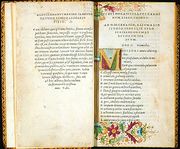
Venice has also inspired writers from abroad. Shakespeare set Othello and The Merchant of Venice in the city. Thomas Mann authored the novel Death in Venice, published in 1912. Venice inspired the poetry of Ezra Pound, who wrote his first literary work in the city. Pound died in 1972 and his remains are buried in Venice's cemetery island of St. Michael. The French writer Philippe Sollers spent most of his life in Venice and published A Dictionary For Lovers Of Venice in 2004. Ugo Foscolo (1778–1827) born in Zante, an island which at the time belonged to the Republic of Venice, was also a famous poet and revolutionary who wanted to see a free republic established in Venice following the fall to Napoleon. The city features prominently in Henry James' The Wings of the Dove and is also visited in Evelyn Waugh's Brideshead Revisited and Marcel Proust's In Search of Lost Time.
Venice is also linked to the technical aspects of writing. The city was the location for one of Italy's earliest printing presses, established by Aldus Manutius (1449–1515). From this beginning Venice developed as an important typographic center and even as late as the 18th century was responsible for printing half of Italy's published books.
Art and printing
_002.jpg)
Venice, especially during the Middle-Ages, Renaissance and Baroque, was a major centre of art and developed a unique style known as the Venetian School. In the Middle-Ages and the Renaissance, Venice, along with Florence and Rome, became one of the most important centres of art in Europe, and numerous wealthy Venetians became patrons of the arts. Venice at the time was a rich and prosperous Maritime Republic, which controlled a vast sea and trade empire.[44]
By the end of the 15th century, Venice had become the European capital of printing, being one of the first cities in Italy (after Subiaco and Rome) to have a printing press after those established in Germany, having 417 printers by 1500. The most important printing office was the Aldine Press of Aldus Manutius, which in 1499 printed the Hypnerotomachia Poliphili, considered the most beautiful book of Renaissance, and established modern punctuation, the page format and italic type, and the first printed work of Aristotle.
In the sixteenth century Venetian painting was developed through influences from the Paduan School and Antonello da Messina, who introduced the oil painting technique of the van Eyck brothers. It is signified by a warm colour scale and a picturesque use of colour. Early masters where the Bellini and Vivarini families, followed by Giorgione and Titian, then Tintoretto and Veronese. In the early 16th century, also, there was rivalry between whether Venetian painting should use disegno or colorito[45].
Canvases (the common painting surface) originated in Venice during the early renaissance. These early canvases were generally rough.
In the eighteenth century Venetian painting had a renaissance because of Tiepolo's decorative painting and Canaletto's and Guardi's panoramic views.
Glass

Venice is famous for its ornate glass-work, known as Venetian glass. It is world-renowned for being colourful, elaborate, and skilfully made.
Many of the important characteristics of these objects had been developed by the thirteenth century. Toward the end of that century, the center of the Venetian glass industry moved to Murano.
Byzantine craftsmen played an important role in the development of Venetian glass, an art form for which the city is well-known. When Constantinople was sacked by the Fourth Crusade in 1204, some fleeing artisans came to Venice. This happened again when the Ottomans took Constantinople in 1453, supplying Venice with still more glassworkers. By the sixteenth century, Venetian artisans had gained even greater control over the color and transparency of their glass, and had mastered a variety of decorative techniques.
Despite efforts to keep Venetian glassmaking techniques within Venice, they became known elsewhere, and Venetian-style glassware was produced in other Italian cities and other countries of Europe.
Some of the most important brands of glass in the world today are still produced in the historical glass factories on Murano. They are : Venini, Barovier & Toso, Pauly, Millevetri, Seguso.[46] Barovier & Toso is considered one of the 100 oldest companies in the world, formed in 1295.
One of the most renowned types of Venetian glasses are made in Murano, known as Murano glass, which has been a famous product of the Venetian island of Murano for centuries. Located off the shore of Venice, Italy, Murano was a commercial port as far back as the 7th century. By the 10th century it had become a well-known city of trade. Today Murano remains a destination for tourists and art and jewellery lovers alike.
Festivals
The Carnival of Venice is held annually in the city, starting around two weeks before Ash Wednesday and ends on Shrove Tuesday. The carnival is closely associated with Venetian masks.
The Venice Biennale is one of the most important events in the arts calendar. During 1893 headed by the mayor of Venice, Riccardo Selvatico, the Venetian City Council passed a resolution on 19 April to set up an Esposizione biennale artistica nazionale (biennial exhibition of Italian art), to be inaugurated on 22 April 1895.[47] Following the outbreak of hostilities during the Second World War, the activities of the Biennale were interrupted in September 1942, but resumed in 1948.[48]
The Venice Film Festival (Italian Mostra Internazionale d'Arte Cinematografica di Venezia) is the oldest film festival in the world. Founded by Count Giuseppe Volpi di Misurata in 1932 as the "Esposizione Internazionale d'Arte Cinematografica", the festival has since taken place every year in late August or early September on the island of the Lido, Venice, Italy. Screenings take place in the historic Palazzo del Cinema on the Lungomare Marconi. It is one of the world's most prestigious film festivals and is part of the Venice Biennale.
Foreign words of Venetian origin
- Arsenal, Ciao, Ghetto, Gondola, Lagoon, Lazaret, Lido, Montenegro, Quarantine, Regatta.
- "Venezuela" means "little Venice".
Notable people
For people from Venice, see People from Venice. Others closely associated with the city include:
- Enrico Dandolo (c. 1107, 1205), Doge of Venice from 1192 to his death. He played a direct role in the Sack of Constantinople during the Fourth Crusade.
- Marco Polo (15 September 1254 - 8 January 1324), trader and explorer, one of the first Westerners to travel the Silk Road to China. While a prisoner in Genoa, he dictated in the tale of his travels known as Il Milione (The Travels of Marco Polo).
- Giovanni Bellini (c. 1430-1516), a Renaissance painter, probably the best known of the Bellini family of painters.
- Aldus Manutius (1449–1515), one of the most important printers in history.
- Pietro Bembo (20 May 1470 - 18 January 1547), cardinal and scholar.
- Lorenzo Lotto (c.1480 - Loreto, 1556), painter, draughtsman, and illustrator, traditionally placed in the Venetian school.
- Sebastian Cabot (c. 1484–1557, or soon after), explorer.
- Pellegrino Ernetti, Catholic priest and exorcist
- Titian (c. 1488-90 – 27 August 1576), leader of the 16th century Venetian school of the Italian Renaissance (he was born in Pieve di Cadore).
- Sebastiano Venier, (c. 1496 - 3 March 1578), Doge of Venice from 11 June 1577 to 1578.
- Andrea Gabrieli (c.1510–1586), Italian composer and organist at St Mark's Basilica
- Tintoretto (1518 - 31 May 1594), probably the last great painter of Italian Renaissance.
- Veronica Franco (1546–1591), poet and courtesan during the Renaissance
- Giovanni Gabrieli (between 1554 and 1557–1612), composer and organist at St Mark's Basilica
- Claudio Monteverdi (1567–1643), composer and director of music at San Marco
- Leon Modena (1571–1648) preacher, author, poet, active in the Venetian ghetto and beyond
- Marco Antonio Bragadin (d.1571), general, flayed alive by the Turks after a fierce resistance during the siege of Famagusta
- Baldassare Longhena (1598 - 18 February 1682), one of the greatest exponents of Baroque architecture.
- Francesco Cavalli (14 February 1602 - 14 January 1676), a baroque composer
- Pietro Cesare Alberti (1608–1655), considered the first Italian-American, arriving in New Amsterdam in 1635.
- Tomaso Albinoni (8 June 1671 - 17 January 1751), a baroque composer
- Rosalba Carriera (7 October 1675 – 15 April 1757), known for her pastel works.
- Antonio Vivaldi (4 March 1678, 28 July (or 27), 1741, Vienna), famous composer and violinist of the Baroque Era
- Pietro Guarneri (14 April 1695 - 7 April 1762) left Cremona in 1718, settled in Venice. "Peter of Venice" from the family of great luthiers.
- Giovanni Battista Tiepolo (5 March 1696 - 27 March 1770), the last "Grand Manner" fresco painter from the Venetian Republic.
- Canaletto (28 October 1697 - 19 April 1768), famous for his landscapes or vedute of Venice, but not only.
- Carlo Goldoni (25 February 1707 - 6 February 1793). Along with Pirandello, Goldoni is probably the most famous name in Italian theatre, in his country and abroad.
- Carlo Gozzi (13 December 1720 – 4 April 1806), an excellent dramatist of 18th century.
- Giacomo Casanova (1725–1798), in Dux, Bohemia, (now Duchcov, Czech Republic), a famous Venetian adventurer, writer and womanizer.
- Lorenzo Da Ponte (1749–1838), opera librettist and poet. He wrote the librettos for 28 operas by 11 composers, including Wolfgang Amadeus Mozart.
- Virgilio Ranzato (7 May 1883 – 20 April 1937), Composer.
- Carlo Scarpa (2 June 1906 - 1978, Sendai, Japan), an architect with a profound understanding of materials.
- Emilio Vedova (9 August 1919 - 25 October 2006), one of the most important modern painters of Italy
- Elena Lucrezia Cornaro Piscopia (5 June 1646 - 26 July 1684), the first woman in the world to receive a doctorate degree.
- Bruno Maderna (21 April 1920 - 13 November 1973), an Italian-German orchestra director and 20th century music composer.
- Luigi Nono (29 January 1924 - 8 May 1990), a leading composer of instrumental and electronic music.
- Ludovico de Luigi (November 1933), Venetian Surrealistic artist.
- Giuseppe Sinopoli (2 November 1946 – 20 April 2001), conductor and composer.
- Romano Scarpa (27 September 1927, Venice - 23 April 2005, Málaga), was one of the most famous Italian creators of Disney comics.
Twin towns — Sister cities
 Palembang, Indonesia.
Palembang, Indonesia. Suzhou, China, since 1980
Suzhou, China, since 1980 Tallinn, Estonia
Tallinn, Estonia Pereira, Colombia
Pereira, Colombia Istanbul, Turkey, since 1993
Istanbul, Turkey, since 1993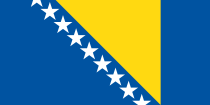 Sarajevo, Bosnia and Herzegovina, since 1994
Sarajevo, Bosnia and Herzegovina, since 1994 Nuremberg, Germany, since 1999
Nuremberg, Germany, since 1999 Qingdao, China, since 2001
Qingdao, China, since 2001 Saint Petersburg, Russia, since 2002
Saint Petersburg, Russia, since 2002 Thessaloniki, Greece, since 2003
Thessaloniki, Greece, since 2003 Fort Lauderdale, United States, since 2007
Fort Lauderdale, United States, since 2007 Wolverhampton, England
Wolverhampton, England
Cooperation agreements
Venice has cooperation agreements with the Greek city of Thessaloniki, the German city of Nuremberg, signed on 25 September 1999, and the Turkish city of Istanbul, signed on 4 March 1993, within the framework of the 1991 Istanbul Declaration. It is also a Science and Technology Partnership City with Qingdao, China.
The City of Venice and the Central Association of Cities and Communities of Greece (KEDKE) established, in January 2000, in pursuance of the EC Regulations n. 2137/85, the European Economic Interest Grouping (E.E.I.G.) Marco Polo System to promote and realise European projects within transnational cultural and tourist field, particularly referred to the artistic and architectural heritage preservation and safeguard.
Etymology
The name is connected with the people known as the Veneti, perhaps the same as the Eneti (Ενετοί). The meaning of the word is uncertain. Connections with the Latin verb 'venire' (to come) or (Slo)venia are fanciful. A connection with the Latin word venetus, meaning 'sea-blue', is possible. Given that Venice was once a Phoenician colony, there is some speculation that the name 'Venice' has its roots in the name of the Phoenician empire.
See also
- List of architecture monuments of Venice
- List of painters and architects of Venice
- Venetian Ghetto
- Jewish Community of Venice
- Su e zo per i ponti
- Veneti and Venetic language (the ancient spoken language of the region)
- S.S.C. Venezia
- Venetian Blinds
- Venetian glass
- Venetian language (the modern spoken vernacular of the region)
- Venezia Mestre Rugby FC - rugby team
- Venice Biennale
- Venice Film Festival
- Padua
- Treviso
- Venice European Capital of Culture 2019
Several cities have been compared to Venice: The Breton city Nantes has been called The Venice of the West, many places have been named Venice of the East, while equally as many have been called Venice of the North.
References
Notes
- ↑ "Online Etymology Dictionary". http://www.etymonline.com/index.php. Retrieved 2010-06-11.
- ↑ Richard Stephen Charnock (1859). Local etymology: a derivative dictionary of geographical names. Houlston and Wright. p. 288.
- ↑ Barzini, Luigi (30 May 1982). "The Most Beautiful City In The World - The". New York Times. http://query.nytimes.com/gst/fullpage.html?res=950CE5DD1038F933A05756C0A964948260&sec=&spon=&pagewanted=2. Retrieved 28 March 2009.
- ↑ "Europes most romantic city breaks". The Times (London). 17 June 2007. http://www.timesonline.co.uk/tol/travel/holiday_type/breaks/article1936951.ece. Retrieved 27 May 2010.
- ↑ Mara Rumiz, Venice Demographics Official Mock funeral for Venice's 'death'
- ↑ "Venetian Music of the Renaissance". Vanderbilt.edu. 11 October 1998. http://www.vanderbilt.edu/Blair/Courses/MUSL242/f98/venice.htm. Retrieved 22 April 2010.
- ↑ "Imperciocchè nascendi i principati", begins Apostolo Zeno, Compendio della storia Veneta di Apostolo Zeno continuata fino alla caduta della repubblica 1847:9.
- ↑ Bosio, Le origini di Venezia
- ↑ Zeno, Compendio 1847:10.
- ↑ Traditional date as given in William J. Langer, ed. An Encyclopedia of World History.
- ↑ According to John Julius Norwich, the traditional first doge of Venice, Paolo Lucio Anafesto, was a mistake for the exarch Paul, whose magister militum was named Marcellus, the same name as Paoluccio's reputed successor as doge, Marcellus Tegallianus.
- ↑ John Julius Norwich, A History of Venice (Alfred B. Knoft: New York, 1982) p p. 13.
- ↑ Langer.
- ↑ Richard Cowen, The importance of salt
- ↑ Herrin, Byzantium: The Surprising Life of a Medieval Empire, Penguin, Harmondsworth, ISBN 978-0-14-103102-6
- ↑ "History of Venice". Historyworld.net. http://www.historyworld.net/wrldhis/PlainTextHistories.asp?ParagraphID=fqa. Retrieved 28 March 2009.
- ↑ James Burke, Connections (Little, Brown and Co., 1978/1995, ISBN 0-316-11672-6, p.105
- ↑ "A Splendid Exchange: How Trade Shaped the World". William J. Bernstein (2008).
- ↑ State of Texas, Texas Department of State Health Services. "History of Plague". Dshs.state.tx.us. http://www.dshs.state.tx.us/preparedness/bt_public_history_plague.shtm. Retrieved 28 March 2009.
- ↑ "Santa Maria della Salute Church". Europeforvisitors.com. http://europeforvisitors.com/venice/articles/santa_maria_della_salute.htm. Retrieved 28 March 2009.
- ↑ Italian site about Schiavoni
- ↑ Patrick G. Skelly, Pocasset MA (6 May 2005). "US Army Air Force Operations Mediterranean Theater". Milhist.net. http://www.milhist.net/usaaf/mto.html. Retrieved 27 July 2010.
- ↑ Patrick G. Skelly, Pocasset MA (21 July 1945). "New Zealand troops relieve Venice". Milhist.net. http://www.milhist.net/history/onemoreriver.html. Retrieved 28 March 2009.
- ↑ Technology: Venetians put barrage to the test against the Adriatic. New Scientist magazine. 15 April 1989. http://media.newscientist.com/article/mg12216602.900-technology-venetians-put-barrage-to-the-test-against-theadriatic-.html. Retrieved 10 October 2007.
- ↑ "Venice's 1,500-year battle with the waves". BBC News. 17 July 2003. http://news.bbc.co.uk/2/hi/europe/3069305.stm. Retrieved 10 October 2007.
- ↑ "Tabella Climo". MeteoAM. http://www.meteoam.it/modules.php?name=viewClinoFile&station=105&name_station=Venezia%20Tessera. Retrieved 2009-05-29.
- ↑ 27.0 27.1 27.2 "The economy of Venice, Italy". Aboutvenice.org. http://www.aboutvenice.org/economy-of-venice.html. Retrieved 22 April 2010.
- ↑ "Venice (Italy) :: Economy - Britannica Online Encyclopedia". Britannica.com. http://www.britannica.com/EBchecked/topic/625298/Venice/24381/Economy. Retrieved 22 April 2010.
- ↑ 29.0 29.1 29.2 29.3 29.4 "Venice (Italy) :: Economy - Britannica Online Encyclopedia". Britannica.com. http://www.britannica.com/EBchecked/topic/625298/Venice/24381/Economy#. Retrieved 22 April 2010.
- ↑ Owen, Richard (5 April 2007). "Venice in peril as the tourists flood in and locals get out". The Times (London). http://www.timesonline.co.uk/tol/travel/destinations/italy/article1615074.ece. Retrieved 27 May 2010.
- ↑ "Top 150 City Destinations London Leads the Way > Euromonitor archive". Euromonitor.com. 11 October 2007. http://www.euromonitor.com/Top_150_City_Destinations_London_Leads_the_Way. Retrieved 22 April 2010.
- ↑ "Bridges of Venice". A Bridge to Venezia. http://www.abridgetovenezia.com/ponts.php?langue=en. Retrieved 22 April 2010.
- ↑ Home Page", Wizz Air
- ↑ Thomas Cook European Timetables
- ↑ "Statistiche demografiche ISTAT". Demo.istat.it. http://demo.istat.it/bil2007/index.html. Retrieved 28 March 2009.
- ↑ Cathy Newman, "Vanishing Venice", National Geographic, August 2009
- ↑ "Venetian Ghetto - Eruv in Venice". http://www.ghetto.it/ghetto/en/foto.asp?padre=3&figlio=1. Retrieved 2010-08-02.
- ↑ "Rumor: Assassin's Creed II Moves To Venice - Playstation 3". Kotaku. 24 February 2009. http://kotaku.com/5159714/rumor-assassins-creed-ii-moves-to-venice. Retrieved 22 April 2010.
- ↑ Touring Club p. 79
- ↑ 40.0 40.1 Miller (2005) p.82
- ↑ Miller (2005) p.83
- ↑ 42.0 42.1 Patner, Josh (2006-02-26). "From Bags to Riches". The New York Times. http://www.nytimes.com/2006/02/26/style/tmagazine/t_w_p166_talk_patner_.html. Retrieved 2010-05-14.
- ↑ Ethnologue.
- ↑ "The Renaissance in Venice - Art History Basics on the Venetian School - ca 1450-1600". Arthistory.about.com. 29 October 2009. http://arthistory.about.com/cs/arthistory10one/a/ven_ren.htm. Retrieved 22 April 2010.
- ↑ "Venetian art around 1500". Webexhibits.org. http://www.webexhibits.org/feast/context/venetianart.html. Retrieved 22 April 2010.
- ↑ Carl I. Gable, Murano Magic: Complete Guide to Venetian Glass, its History and Artists (Schiffer, 2004). ISBN 0-7643-1946-9.
- ↑ "The Venice Biennale: History of the Venice Biennale". Labiennale.org. http://www.labiennale.org/en/biennale/history/origin/en/7823.html. Retrieved 28 March 2009.
- ↑ "The Venice Biennale: History From the beginnings until the Second World War (1893-1945)". Labiennale.org. http://www.labiennale.org/en/biennale/history/origin/en/7823.3.html. Retrieved 28 March 2009.
Bibliography
- Academic
- Bosio, Luciano. Le origini di Venezia. Novara: Istituto Geografico De Agostini.
- Chambers, D.S. (1970). The Imperial Age of Venice, 1380-1580. London: Thames & Hudson. The best brief introduction in English, still completely reliable.
- Contarini, Gasparo (1599). The Commonwealth and Gouernment of Venice. Lewes Lewkenor, trsl. London: "Imprinted by I. Windet for E. Mattes." The most important contemporary account of Venice's governance during the time of its blossoming. Also available in various reprint editions.
- Drechsler, Wolfgang (2002). "Venice Misappropriated." Trames 6(2), pp. 192–201. A scathing review of Martin & Romano 2000; also a good summary on the most recent economic and political thought on Venice.
- Garrett, Martin, "Venice: a Cultural History" (2006). Revised edition of "Venice: a Cultural and Literary Companion" (2001).
- Grubb, James S. (1986). "When Myths Lose Power: Four Decades of Venetian Historiography." Journal of Modern History 58, pp. 43–94. The classic "muckraking" essay on the myths of Venice.
- Lane, Frederic Chapin. Venice: Maritime Republic (1973) (ISBN 0-8018-1445-6) standard scholarly history; emphasis on economic, political and diplomatic history
- Laven, Mary, "Virgins of Venice: Enclosed Lives and Broken Vows in the Renaissance Convent (2002). The most important study of the life of Renaissance nuns, with much on aristocratic family networks and the life of women more generally.
- Martin, John Jeffries and Dennis Romano (eds). Venice Reconsidered. The History and Civilization of an Italian City-State, 1297-1797. (2002) Johns Hopkins University Press. The most recent collection on essays, many by prominent scholars, on Venice.
- Muir, Edward (1981). Civic Ritual in Renaissance Venice. Princeton UP. The classic of Venetian cultural studies, highly sophisticated.
- Oppenheimer, Gerald J. (2010). Venetian Palazzi and Case: A Guide to the Literature. University of Washington, Seattle. Retrieved from http://faculty.washington.edu/gerryo/venice.html February 7, 2010.
- Rösch, Gerhard (2000). Venedig. Geschichte einer Seerepublik. Stuttgart: Kohlhammer. In German, but the most recent top-level brief history of Venice.
- Miller, Judith (2005). Furniture: world styles from classical to contemporary. DK Publishing. ISBN 075661340X.
- Popular
- Ackroyd, Peter. Venice: Pure City. London, Chatto & Windus. 2009. ISBN 978-0-7011-8478-0
- Cole, Toby. Venice: A Portable Reader, Lawrence Hill, 1979. ISBN 0-88208-097-0 (hardcover); ISBN 0-88208-107-1 (softcover).
- Morris, Jan (1993), Venice. 3rd revised edition. Faber & Faber, ISBN 0-571-16897-3. A subjective and passionate written introduction to the city and some of its history. Not illustrated.
- Ruskin, John (1853). The Stones of Venice. Abridged edition Links, JG (Ed), Penguin Books, 2001. ISBN 0-14-139065-4. Seminal work on architecture and society
- di Robilant, Andrea (2004). A Venetian Affair. Harper Collins. ISBN 1-84115-542-X Biography of Venetian nobleman and lover, from correspondence in the 1750s.
- Sethre, Janet. The Souls of Venice McFarland & Company, Inc., 2003. ISBN 0-7864-1573-8 (softcover). This book focuses on people who have been shaped by Venice and who have shaped the city in their turn. Illustrated (photographs by Manuela Fardin).
External links
- Venice travel guide from Wikitravel
- Official Site of the City of Venice
- Saint Mark Church
- Venise La Sérénissime French Site
- Photo Gallery of Venice
- Geschichte Venedigs. Politik (German)
- 360cities ponte di Rialto - panorama 360°
- 360cities campo delle Gorne - panorama 360°
- 360cities fondamenta de la Preson - panorama 360°
- Website and guide on Venezia
- Venice Travel Guide VIDEO (English)
|
|||||||
|
|||||||||||
|
|||||||||||||||||||||||||||||||
|
|||||||
_-_The_Last_Supper_(1495-1498).jpg)


